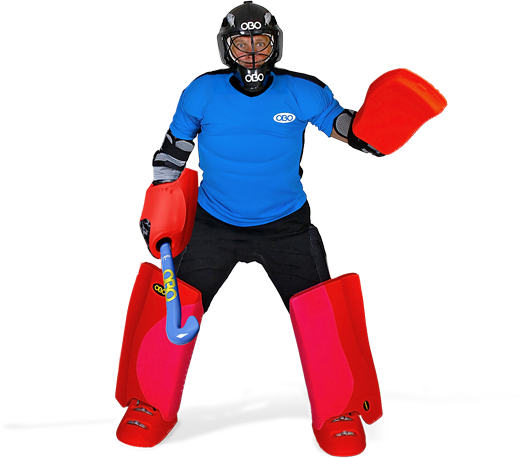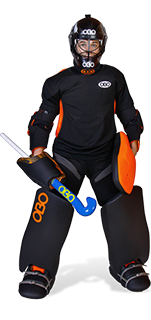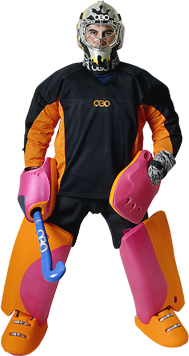KEEPERS RESOURCES

Being set for the shot
If you have ever seen a goalkeeper running out in the attempt to get in front of a shot, only to miss the ball and end up allowing a goal, then you will have seen first hand the inability to save on the move; it’s simply just not possible to move a limb to block whilst moving at the same time. In contrast, if you stop moving, you will be able to make a balanced save (whereas running would throw you off balance). By limiting your movement (which often involves playing deep within the D and close to the goal line; cutting down the distance you have to move), you are able to get behind the angle and therefore stop the shot successfully. Obviously, though, whenever a breakdown occurs in the defence and the goalkeeper is forced into moving out to challenge and cover space, then you will need to move across.
Still moving
If you are moving with the play, there is very little likelihood that you will actually be able to make the save. Racing out to instantly cut the angles and pressure the shooter, you will normally end up losing balance within your ready stance. Unable to stop within the stance and properly move your legs in order to block the incoming shot, your forward momentum will carry you away from ball and the result will be an allowed goal. Staying up is more advantageous as you cover more of the goal, so you need to find a way to cut down the movement you have to make to get behind the shot.
Effectively, the only time you would purposefully choose to make an active save on the move, is when opting to slide out against the play to block; choosing to play the percentages and cover as much as possible against the shot. Whereas normally you would have no chance of blocking on the move; like moving across laterally against a passing play, which you cannot stop upright as you simply cannot move with the play in time, trying to save with a piece of equipment; forcing you to leave your feet and dive into the save.
Problems surrounding being still ‘on the move’:
- you are still moving, so cannot stop in time, or stop your momentum, in order to be able to make a save
- you cannot get set (in your stance, or in relation to your angles and goal positioning), if you are still moving
- you are unable to properly balance and therefore make a ‘good’ save
- with your momentum, you are also moving away from the shot, rather than into its path
These problems essentially mean that a successful save is impossible: the chances are in favour of the ball ending up in the goal because of loss of balance and moving away from the shot.
Pre-set
In order to get set in a balanced ready stance on the angle in time, you need to consciously get yourself prepared; getting into position before the shot. Setting before the shot, rather than setting on the shot, or trying to attempt a save whilst still on the move, allows you to make a more efficient save by being balanced in a solid ready position. Properly balanced and prepared for the save you will next have to make, you are in a better position to keep the ball out of the net. Even if you are not on the best angle, you are still ready in your stance; giving you are better chance to make the save, than if you were trying to move onto the angle and still moving when the shot was released.
Pointers:
- try to minimise movement; take less steps and cut down on , so you have more time to prepare
- get set early before the shot is released (e.g. instead of taking another step, stop and get into your stance, so that you are ready)
- make sure you have a balanced ready stance in order to maximise your chances of making the save
- always maintain your ready position throughout moving around in the D, so that you are already set in readiness for getting ready for a shot (minimising the time needed to get into a good stance), regardless of whether you end up facing a shot or not
Rule of thumb
– If it is a point shot you are facing, then get into a good position and be well balanced before the shot. However, if it is a passing play, then you will need to be agile to get across in time.
In essence, you don’t want to over step: still moving means that you are not ready for the save, so by being precise and conservative with your movements, you are more capable of shot stopping by simply arriving on time as it were to meet the shot – being in the right place at the right time for a successful save.
Get set!
Ultimately, you need to pre-set for shots when you are seeing straight shots at you. If you are faced with a 2 on 0, then you need to react to get across to block the ball on the pass. You need to consciously think about getting set, so that you are always moving with the play; ready to get into the correct position against the incoming shot. Try to play a smaller D so that you have less to do; moving less and being able to get on the angle quicker. Maintain a balanced ready stance all the time, so that your task is made easier by being already prepared for the save.
Comments
Leave Your Comments Below















